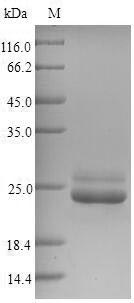Recombinant Arabidopsis thaliana 2-Cys peroxiredoxin BAS1, chloroplastic (BAS1) is produced in a yeast expression system, covering the mature protein from amino acids 66 to 266. The protein is expressed with an N-terminal 6xHis-tag to aid in purification and detection. Purity exceeds 90% as verified by SDS-PAGE, which appears to ensure reliable results for research applications.
2-Cys peroxiredoxin BAS1 plays a critical role in redox regulation within chloroplasts of Arabidopsis thaliana. It's involved in detoxifying peroxides and maintaining cellular redox homeostasis. This protein serves as a valuable tool for studying oxidative stress responses and redox signaling pathways in plants. It may provide insights into plant physiology and stress tolerance mechanisms.
Potential Applications
Note: The applications listed below are based on what we know about this protein's biological functions, published research, and experience from experts in the field. However, we haven't fully tested all of these applications ourselves yet. We'd recommend running some preliminary tests first to make sure they work for your specific research goals.
Arabidopsis thaliana BAS1 is a chloroplastic 2-Cys peroxiredoxin that requires precise folding, disulfide bond formation, and proper oligomerization for its redox regulatory activity. The yeast expression system provides a eukaryotic environment that supports proper protein folding and disulfide bond formation, increasing the probability of correct folding compared to bacterial systems. However, as a chloroplast-targeted protein, BAS1 may require specific chloroplast-specific modifications or chaperones for optimal folding. The N-terminal 6xHis tag is relatively small but may potentially interfere with the protein's N-terminal structural organization. While yeast expression provides favorable conditions, experimental validation remains essential to confirm structural integrity and enzymatic activity.
1. Protein-Protein Interaction Studies Using His-Tag Pull-Down Assays
This application requires proper folding validation. Peroxiredoxin interactions within redox networks require precise tertiary structure. If correctly folded (verified), the protein is suitable for identifying physiological interaction partners in chloroplast redox systems. If misfolded/unverified, there is a high risk of non-specific binding or failure to identify genuine redox partner interactions.
2. Antibody Development and Validation
Antibody development relies primarily on antigenic sequence recognition. If correctly folded (verified), the protein excels for generating conformation-sensitive antibodies that recognize native BAS1 epitopes. If misfolded/unverified, it remains suitable for producing antibodies against linear epitopes, which are still valuable for detection applications in plant research.
3. Biochemical Characterization and Enzyme Kinetics Analysis
These studies are essential for determining folding status and functional competence. If correctly folded (verified), characterization provides reliable data on peroxidase activity, oligomerization state, and redox properties. If misfolded/unverified, analysis yields physical property data, but enzymatic assays will not reflect native activity.
4. Comparative Structural and Functional Studies
This application depends on correct folding validation. Meaningful comparative studies require native protein conformation. If correctly folded (verified), the protein enables valid comparisons with other plant peroxiredoxins. If misfolded/unverified, comparative analyses would yield misleading results about evolutionary relationships.
Final Recommendation & Action Plan
The yeast expression system provides favorable folding conditions for this plant peroxiredoxin, but experimental validation of structural integrity and enzymatic activity is essential before reliable use in functional studies. Begin with Application 3 (Biochemical Characterization) to assess folding quality through size-exclusion chromatography (oligomerization state), circular dichroism spectroscopy, and validate peroxidase activity using standard substrates like H₂O₂ or organic peroxides. If correct folding and enzymatic activity are verified, proceed cautiously with Applications 1 and 4 for interaction studies and comparative analyses. Application 2 (antibody development) can proceed immediately regardless of folding status. If misfolding is detected, limit applications to linear epitope antibody production and basic biophysical characterization, avoiding all functional interaction and comparative studies. For reliable BAS1 research, always include appropriate redox activity controls and consider using plant-based expression systems for complete chloroplast-specific modifications.






